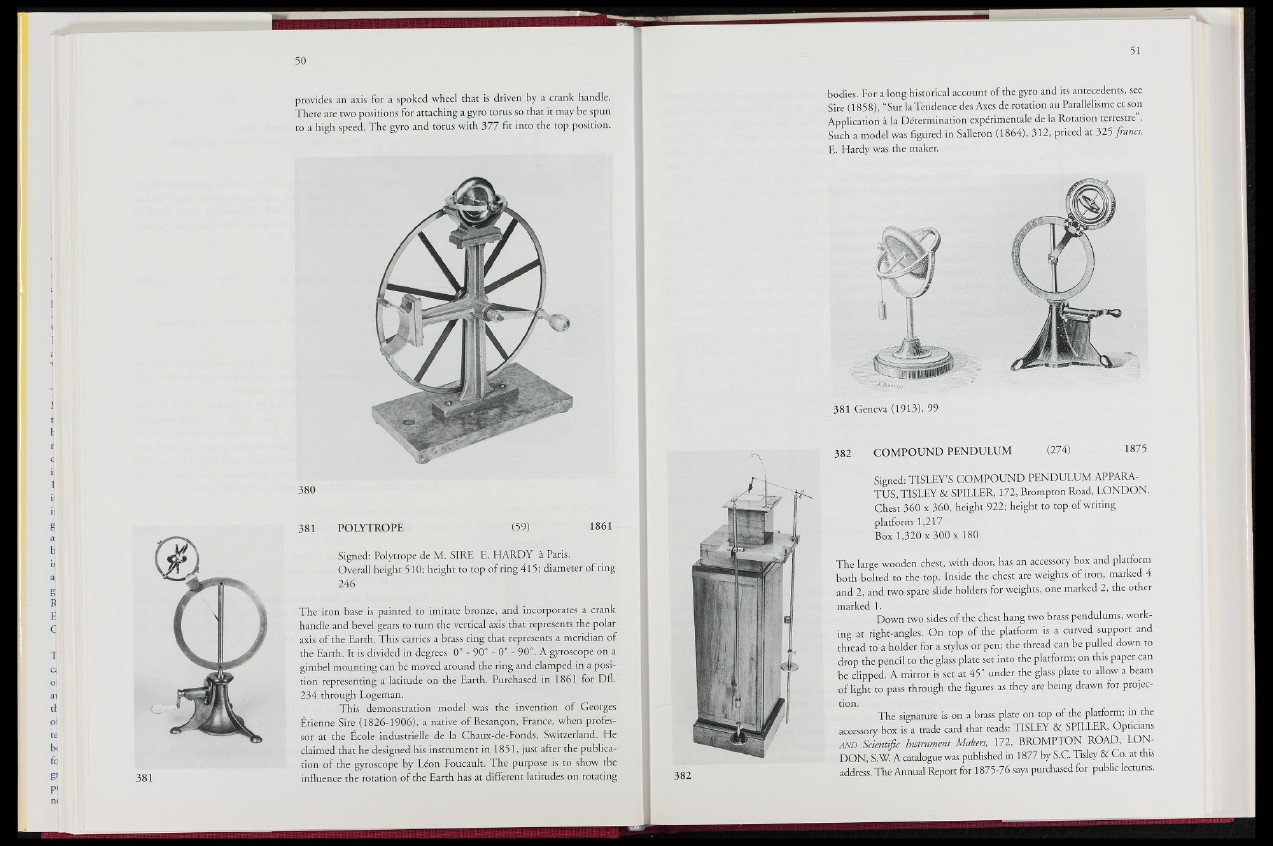
provides an axis for a spoked wheel that is driven by a crank handle.
There are two positions for attaching a gyro torus so that it may be spun
to a high speed. The gyro and torus with 377 fit into the top position.
380
381 POLYTROPE '¥(39) 1861
Signed: Polytrope de M. SIRE E. HARDY à Paris.
Overall height 510; height to top of ring 415; diameter of ring
246
The'iron base is painted to imitate bronze, and incorporates. a crank
handle and bevel gears to turn the vertical axis that represents the polar_
axis of the Earth. This carries a brass ring that represents a meridian o|:
the Earth. It is divided in degrees 0° - 90° - 0” - 90°. A gfoscppe oç|a.;
gimbel mounting can be moved around the ring and clamped in a position
representing a latitude on the Earth. Purchased in 1861 for Dfl.
234 through Logeman.
This demonstration model was the invention of Georges
Étienne Sire ,(1826-1906), a native of Besançon! France, when professor
at the École industrielle de H Chaux-de-Eonds, Switzerland. He
claimed that he designed his instrument in 1851, just after the publfep
tion of the gyroscope by Léon Foucault. The purpose is to show the
influence the rotation of the Earth has at different latitudes on rotating
bodies. For a long historical account of the gyro and its antecedents, see
Sire (1858)ÿ8Sur laTendence des Axes de rotation au Parallélisme et son
Application à la Détermination expérimentale de la Rotation terrestre .
Such a model was figured in Salleron (1864), 312, priced at 325 francs.
E. Hardy was the maker.
381 Geneva (1913)= 99
382 COMPOUND PENDULUM i l i f c ; 1875
Signed: TISLEY’S COMPOUND PENDULUM APPARATUS,
TISLEY & SPILLER.072, Brompton Road, LONDON.
Ghest 360 x 360, height 922; height to top of writing
platform 1,217
BcoX. 1,320 x 300 x 180
The large wooden chest, with door, has an accessory box and platform
both bolted to the top. Inside the chest are weights of iron, marked 4
an.d 2, and two spare slide folders for weights^one marked 2, the other
marked 1.D
own two sides of the chest hang two brass pendulums, work-
ing at right-angl’es. On top of the platform is a curved support and
/thread to a holder ièna stylus or pen; the thread can be pulled down to
drop the pencil to the glass plate set,into the platform; on this paper can
be clipped. A mirror is set at 4 | | under .die glass plate to allow a beam
of light ì|oipàss*h»ugh the figures as they are being drawn fogj|rojec-
tion.
The signature is on a brass plate on top of the platform; in the
accessory box ijgj, trade card that reads: TISLEY & SPILLER, Opticians
AND Scientific Instrument Makers, 1,72, BROMPTON ROAD, LONDON,
SM A catalogue was published in 1877 by S.C. Tisley & Co. at this
address. The Annual Report for 1875-76 says purchased for public lectures.